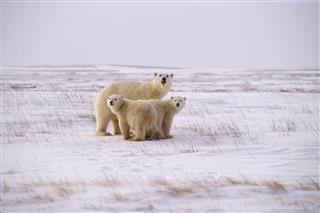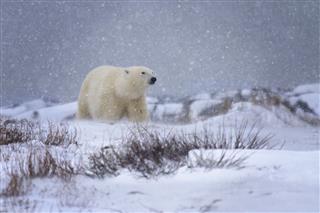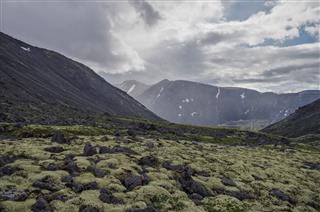
The tundra region is the coldest biome existing on Earth. Although it is one of the most inhospitable habitats in the world, there are surprisingly quite a few interesting plants and animals that exist here.
The world’s major habitats characterized by the dominant forms of plant and animal life along with the climatic and geographical conditions are known as biomes. Each biome’s location is defined by the climate of the region, which in turn, brings in change in the plants and animals inhabiting the region.
Extremely cold temperatures and frozen, treeless landscapes characterize the tundra biome. The landscape is often laden with frost and the region is known for less precipitation, poor quality of nutrients, and extremely low temperatures. In spite of the extreme temperature conditions, the region is well-known for its considerably large ecosystem that dominates a major part of all the subtypes of tundra biome.
What are the Types of Tundra Biome?
- The tundra is divided into three types: the Arctic tundra, the Alpine tundra, and the Antarctica tundra.
- As compared to the Antarctic tundra region, the Arctic tundra is home to a larger amount of flora and fauna.
- The difference between the Arctic and Alpine tundra is that the soil in the Alpine tundra region is not permanently frosted. Therefore, small shrubs are visible in the Alpine tundra region.
- The ecological boundary region, or ecotone, which demarcates the tundra and the growth of the forest is referred to as the timberline or tree line.
Where is the Tundra Biome Found?
Arctic Tundra
It lies between the North Pole and the Taiga or the coniferous forests. In North America, it occurs in Greenland, Canada and Northern Alaska; in northern Europe, it is mainly found in Scandinavia; and in northern Asia, it is found in Siberia.
Alpine Tundra
It can be found at very high elevations on frozen mountaintop regions. In North America, it occurs in Mexico, U.S.A., Canada, and Alaska. In South America, it is found in the Andes Mountains. It occupies the Sweden, Russia, Norway, and Finland regions of Europe. In Africa, it can be found in the Rift Mountains (such as Mt. Kilimanjaro), and in Asia, it occurs in the Himalayan Mountain Ranges — which are located in Southern Asia, and in Mt. Fuji, in Japan.
Antarctic Tundra
It occurs on various Antarctic as well as sub-Antarctic islands, which include the Kerguelen Islands, the South Sandwich Islands, and South Georgia.
What are the Conditions in the Tundra Region?


Arctic Tundra
- The Arctic tundra is considered to be the youngest biome in the world, having been formed 10,000 years ago.
- Located in the latitudes 55° to 70° north, this vast and treeless territory covers approximately 20 percent of the surface of the Earth, encompassing the North Pole.
- Of all the biomes in the world, this region is considered to be the coldest. With less than 10 inches of rain in a year, it is also the driest.
- The main seasons of this tundra region are long winters and short summers. The summers here sometimes last just for 6-10 weeks, while the winters are long.
- Spring and fall are just brief interludes that occur between the winter and summer. During winter, the nights can go on for weeks with the sun barely rising, and the temperature often plummeting as low as -94 °F.
- Due to the Arctic tundra being close to the North Pole, the days in the summer are 24 hours long, which is the reason the Arctic is also referred to as the ‘Land of the Midnight Sun’.
- The temperature in summer rarely rises above 50 °F, which is just sufficient enough to thaw the top layer of the ground, referred to as permafrost.
- The permafrost, which lies about six inches below the surface, remains frozen throughout the year.
- Another characteristic feature of the Arctic tundra is that it is very windy, with winds blowing at 30-60 miles per hour (48-97 kilometers).
Alpine Tundra
On the basis of Köppen climate classification, it is classified in ‘Group E’. It is categorized in this group since the mean temperature never goes beyond 10 °C (50 °F).
Antarctic Tundra
- The average temperature (annually) recorded in the interior part of Antarctica is −57 °C (−70 °F).
- The Antarctic peninsula records 2 °C (36 °F) during summers and can go up to 15 °C (59 °F). During winters, the temperature is just below freezing.
What are the Plants that Grow in the Tundra Biome?
Arctic Tundra
- Considering the extremely inhospitable conditions of the tundra biome, there are as many as 1,700 different plant species that grow here.
- The tundra plants consist mostly of mosses, grasses, lichens, sedges, and shrubs. About 400 types of flowers bloom in the growing season, which lasts just for 50-60 days. Except for a few birches in the lower altitudes, no trees grow in this tundra region.
- Cotton grass (Eriophorum) of the Sedge family and arctic willow, bloom in abundance in the arctic and sub-arctic tundra.
- Because of the permafrost, trees cannot grow their roots into the ground. Although in some parts of this region, willows do grow, they can grow only up to about 8 cm, or 3 inches high.
- Developing over thousands of years, most of the vegetation has adapted to the conditions in this region by growing in a dense mat of roots.
- Except where the soil is fertilized by animal droppings, the soil is low in minerals and nutrients.
Alpine Tundra
- The plants growing in the alpine climate and at a higher elevation (above the tree line) are called alpine plants.
- The prominent plants include varieties of mosses, lichens, sedges, perennial grasses, and cushion plants. Caribou moss (reindeer moss) is seen growing abundantly in the alpine tundra.
Antarctic Tundra
- Being too dry and cold for vegetation to grow, the Antarctica tundra is mostly covered by large expanses of ice fields.
- However, in some parts of the region, especially the Antarctic Peninsula, there are areas where there is rocky soil which can support vegetation.
- The plant species that exist here are aquatic and terrestrial species of algae, occurring in the exposed soil and rock areas around the shore, liverworts, reindeer mosses, sedges, shrubs, and lichens.
- In the western and northern parts of the Antarctic Peninsula, flowering species of plants known as the Antarctic pearlwort and Antarctic hair grass can be found.
Do Any Animals and Birds Live in the Tundra Region?
Animals




Birds




Arctic Tundra
- Even though there is not much biodiversity, with only about 48 species of land mammals occurring in this tundra biome, there are surprisingly large numbers of each species.
- In North America, there are large caribou herds, also called reindeer in Eurasia, and feed on plants and lichens.
- Smaller musk-oxen herds also roam about the frozen regions.
- The predators of this tundra biome are polar bears, arctic foxes, and wolves. Some of the smaller mammals are lemmings and snowshoe rabbits.
- Birds, such as falcons, ravens, snowy owls, arctic terns, and snow geese are observed.
- Although there are not too many types of insects to be found in this biome, tiny midges that bite, mosquitoes, deer flies, and black flies do occur, which can make the summers here quite miserable.
- The mosquitoes that occur prevent themselves from freezing by substituting the water in their bodies with glycerol, which acts like an anti-freeze.
- The marshy regions of this tundra are where migratory birds, like plovers, sandpipers, and harlequin flock to in summer.
Alpine Tundra
- The areas of alpine tundra are spread across various regions of the Earth; thus, there is no particular set of animals or species that is found in all areas.
- The most common species include mountain goats, woodland caribou, marmots, and pikas.
Antarctic Tundra
- Since it is isolated from other continents, the Antarctic tundra — in contrast with the Arctic tundra, is devoid of large mammal species.
- Sea birds and sea mammals, such as penguins and seals, however, do occur in areas close to the shore, while small mammals, like cats and rabbits have been introduced by humans on some of the sub-Antarctic islands.
- There are certain fish, which are peculiar to the cold waters of the tundra region. The most commonly found fish are the trout, salmon, flatfish, and cod.
As is evident, the Tundra biome is not a useless and cold wasteland. In fact, its very nature makes the environment very fragile, and the animals and plants that have made the tundra their home have adapted themselves intricately to its short, although abundant, summers and cold, long winters. They exist on a precarious edge; hence, the most minor of stresses can lead to their destruction.

















